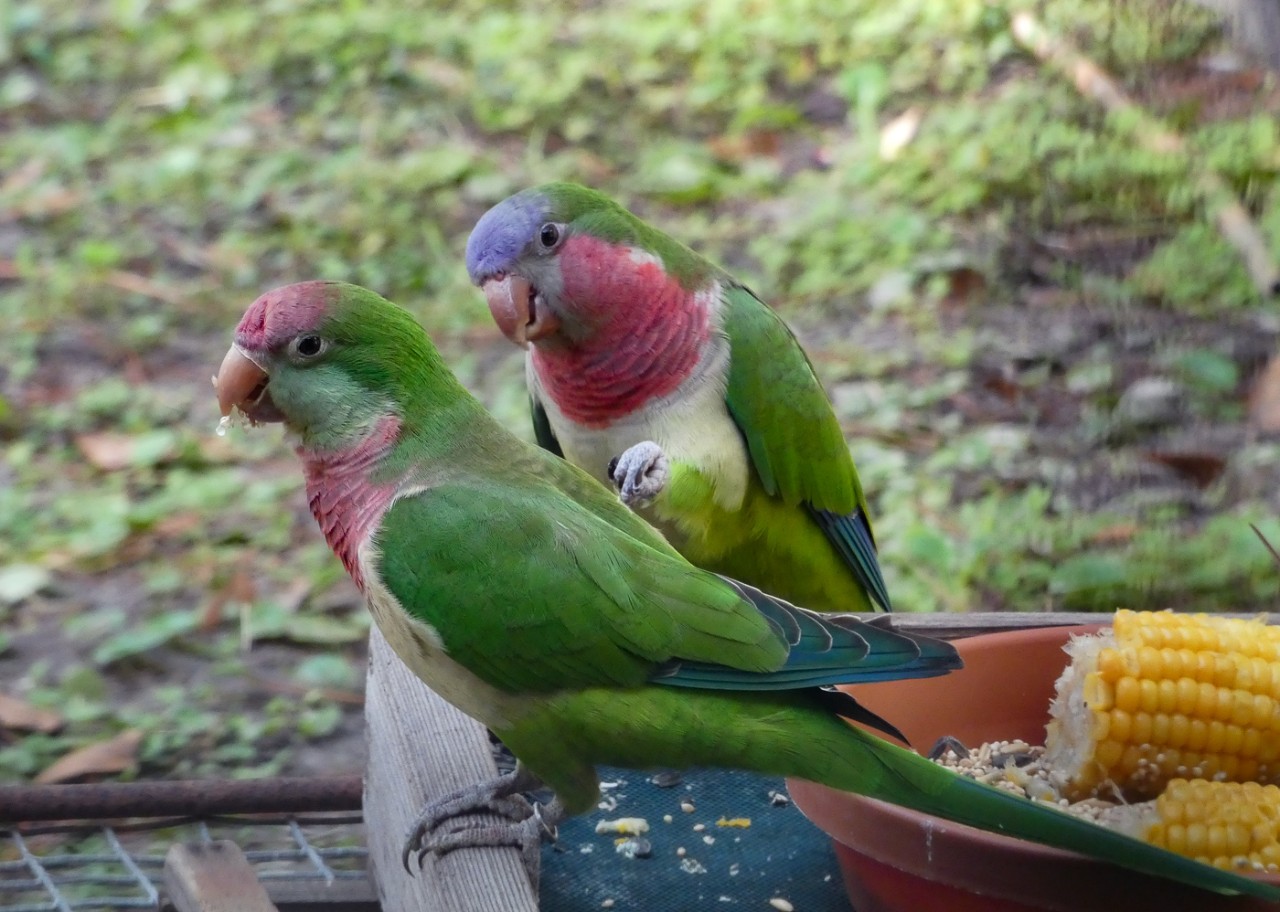
These birds vacation at their peril
Gregarious monk parakeets lose social standing during an absence
Stephen Hawking famously said showing up is half the battle.
Monk parakeets take that saying to heart, according to new research by the University of Cincinnati.
These loud and gregarious parrots risk losing their hard-won social standing if they are absent from their flock for just eight days, biologists found. And the highest-ranking birds lose the most status during their brief absence, researchers found.
The study was published in the journal Behavioral Ecology.

UC Assistant Professor Elizabeth Hobson explains parakeet dominance hierarchies using a glass window overlooking UC's Uptown Campus. Photo/Andrew Higley/UC Marketing + Brand
UC scientists studied three groups of captive monk parakeets in 2021 and 2022. The study, led by postdoctoral researcher Annemarie van der Marel, focused on testing whether social history was a critical component in structuring how the parakeets gained and maintained their ranks within their groups. Researchers were able to identify each bird’s status in the flock’s dominance hierarchy by observing their interactions and quantifying rank using networks of aggression.
Van der Marel, a former postdoctoral researcher at UC, is now a postdoctoral fellow at the Pontifical Catholic University of Chile where she is conducting research on social mammals. But monk parakeets are never far from her mind. Feral parakeets nest outside her home in Santiago.
“They’re loud. They are very affiliative toward some members of the group but can be quite grumpy towards others. There’s a lot of social drama,” van der Marel said.
We predicted that if there was something intrinsic about the bird that gave it high rank, it should have been able to waltz back in and easily retake its former rank.
Elizabeth Hobson, UC Assistant Professor of Biological Sciences
The field crew recorded 100,000 fights over two years of experimentation. They recorded a lot of data on the birds’ efforts to increase or defend their social standing, said Elizabeth Hobson, a behavioral ecologist and assistant professor in UC’s College of Arts and Sciences.
“Monk parakeets are very feisty. They fight all the time,” Hobson said. “They generally don’t have knock-down, drag-out fights, they’re just constantly squabbling.”
Typically, an aggressor will sidle up to another bird and threaten to peck it. Often, the other bird flees before the interaction becomes physical.
“We call it a displacement. It’s clear who the winners and losers are,” Hobson said
Once the hierarchy had formed in the social groups, the researchers removed birds of different social standing for eight days before returning them and observing their reintegration to the flock.
“We predicted that if there was something intrinsic about the bird that gave it high rank, it should have been able to waltz back in and easily retake its former rank,” Hobson said.
Join Hobson's Lab
Are you an undergraduate who is interested in conducting biology research? Join UC Assistant Professor Elizabeth Hobson's lab, where students get a chance to work with bobwhite quail and bettas. Apply here.

UC Assistant Professor Elizabeth Hobson edits a research paper from a window seat in her office. Photo/Andrew Higley/UC Marketing + Brand
Unlike some animal societies where the biggest individual is often dominant, researchers found that size doesn’t matter as much among monk parakeets. Instead, they get ahead through sheer force of will.
“It’s really striking to see a bird that had risen all the way to the top of the hierarchy have their rank fall so dramatically after being absent from the group for only about a week,” Hobson said. “Because this loss of rank isn’t associated with anything we measured about the birds, we think that rank loss is more likely the result of a change in social history, possibly because the removed birds were absent and couldn’t fight to hang onto their spot in the hierarchy.”

UC behavioral ecologist Elizabeth Hobson is unlocking secrets about dominance hierarchies. Photo/Annemarie van der Marel
The new study also found that high-ranked birds had a much more difficult reintegration into their former groups. While lower-ranked birds also experienced a decline in status, it was not nearly as dramatic as in higher-ranked birds.
“The group treats them very differently,” Hobson said. “In general, when we reintroduce the top-ranked bird, the group responds with a lot of aggression towards that reintroduced bird. A lot of bullying happens.
“But when we reintroduced a middle- or low-ranked bird, we didn’t see nearly the kind of focused aggression on that bird as we saw in the top-ranked bird,” she said.
Hobson said it’s possible members of the flock don’t perceive the lower-ranked birds as a threat to their own standing.
“When we take a bird out, there’s a power vacuum and everything shifts to accommodate it,” co-author and UC doctoral student Chelsea Carminito said. “When that bird suddenly comes back, the birds at the top don’t want to relinquish their top rank and will defend their position.”
Carminito is studying the behavior of monk parakeets to learn ways to improve their care and the care of other social birds in captivity and zoos and research centers.
“My interest is how to reduce stress in captive situations when you have to remove a bird,” she said.

Former UC postdoctoral researcher Annemarie van der Marel. Photo/Andrew Higley/UC Marketing + Brand
Van der Marel said the flock’s social structure adapted quickly to the absence or loss of a single bird. In the wild, flocks occasionally lose individuals to predators or disease, so the remaining birds may be adaptable. Less common, she said, is when a high-status bird would return to the flock after a prolonged absence, perhaps from injury. These reintroductions seem to cause more havoc in the social group than removals.
“Monk parakeets have a very complex social system and demonstrate a lot of cognitive complexity,” van der Marel said.
From Hobson’s previous studies, researchers learned that monk parakeets in captive groups can have a keen understanding of their social order and can use this to be selective in picking which birds to target with aggression.
“They spend a lot of time and energy watching each other’s fights and remembering the outcomes,” Hobson said. “They appear to be aware of their ranks and the position of others in these hierarchies.”
In dominance hierarchies, higher rank often confers better access to food and other resources. Hobson said it’s not clear what advantages rank affords monk parakeets in the wild, where it’s more difficult to study the social birds.

Postdoctoral researcher Annemarie van der Marel, left, and UC student Claire O'Connell work with a monk parakeet in a flight cage in Florida. Photo/Hobson Lab
Hobson studied several dozen wild birds she captured and tagged in Argentina, but they would congregate with many others, making it difficult to identify where they fit in the greater social structure.
“In Argentina, people call the parakeets ‘la plaga,’ which means the plague,” Hobson said. “There are thousands and thousands of them..”
In her biology lab, Hobson is using bobwhite quail as a model system to study the formation of relationships and social structure. This year she also added aquariums of colorful bettas, which may also be able to use social information to structure their social interactions and aggression.
“The more similar we can make the experiments and analytical approach, the more potential we have to compare sociality in an apples to apples way across species,” Hobson said.
These new projects on quail and fish sociality and cognition will be supported by a URC Faculty Scholars award granted to Hobson.
“I’m really grateful to UC for supporting these new experiments and I’m excited to see how parakeets, quail, and fish social responses compare,” she said.
Featured image at top: Monk parakeets squabble at a food dish. Photo/Annemarie van der Marel

UC College of Arts and Sciences Assistant Professor Elizabeth Hobson studies animal behavior in her lab. Photo/Andrew Higley/UC Marketing + Brand
Next Lives Here
The University of Cincinnati is leading public urban universities into a new era of innovation and impact. Our faculty, staff and students are saving lives, changing outcomes and bending the future in our city's direction. Next Lives Here.
Related Stories
Ancient Maya used sustainable farming, forestry for millennia
June 24, 2022
University of Cincinnati researchers found evidence of sustainable agriculture and forestry spanning a millennia in one ancient Mayan city.
UC project targets pesky mosquitoes’ genes
February 21, 2022
Researchers at the University of Cincinnati examined genetic material of three species of mosquitoes responsible for killing millions of people around the world each year. In a collaboration between UC’s chemistry and biology departments, researchers revealed the surprising genetic modifications female mosquitoes undergo, in part to create the next generation. Using tools called liquid chromatography-tandem mass spectrometry, researchers found as many as 33 genetic modifications in the transfer RNA of female mosquitoes. Like DNA, transfer RNA serves as the building blocks of life, communicating the genetic code from DNA to build new proteins that regulate the body’s tissues and organs.
Hungry eyes: Spiders lose vision when they’re starving
April 20, 2023
Biologists at the University of Cincinnati discovered that underfed jumping spiders lose light-sensitive cells that are key to their vision.
